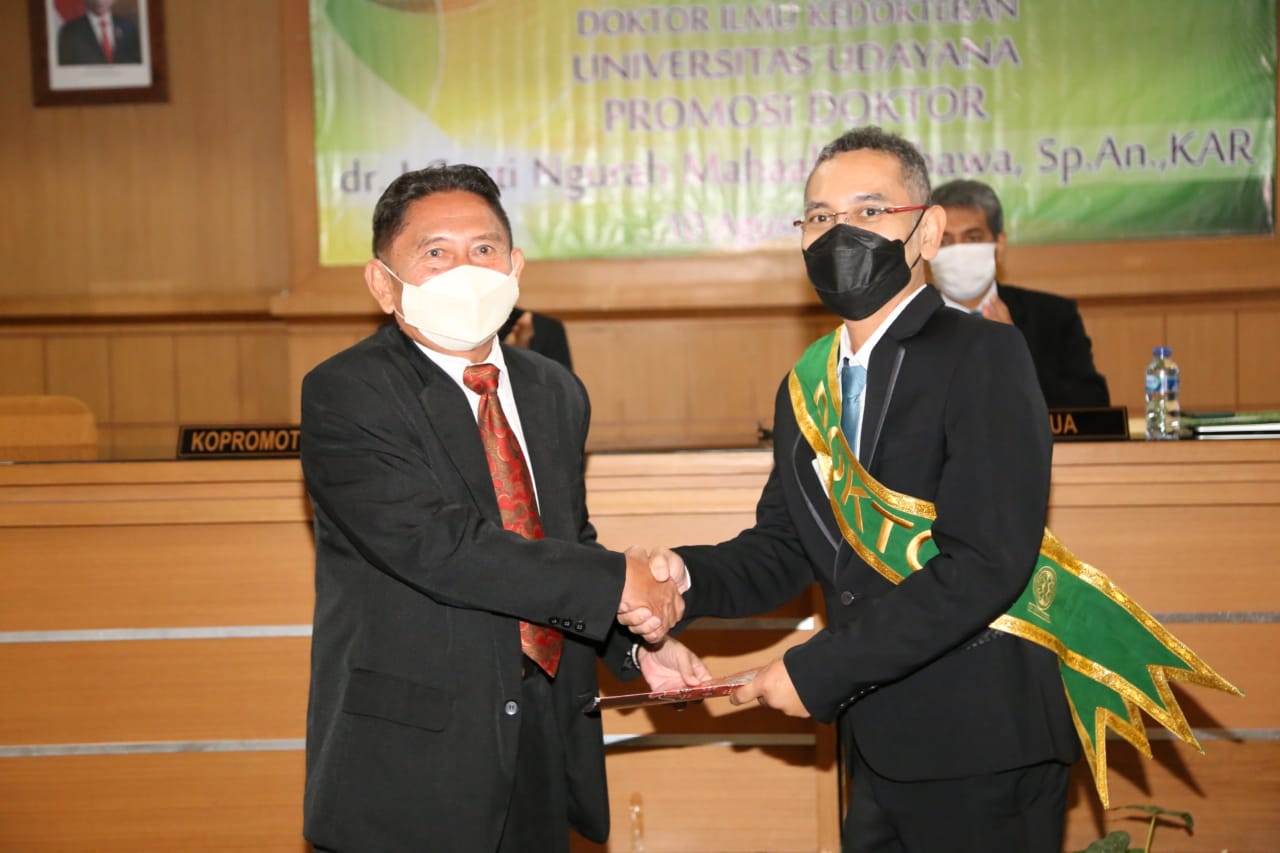IGN Mahaalit Aribawa Receives a Doctorate in Medicine for His Work on Mechanisms to Prevent Postoperative Pain.
Located in the third floor postgraduate courtroom, the Doctoral Promotion exam was held with the promovendus candidate dr. I Gusti Ngurah Mahaalit Aribawa, Sp.An., KAR with the dissertation title "The Effect of Multimodal Analgesia on Monocyte Chemoattractant Protein 1, Brain Derived Neurotropic Factor, Micro RNA-124 in the Acute Pain Phase after Hysterectomy." (10/08/2022)
Postoperative acute pain is still one of the problems in the perioperative period to date, not only in Indonesia but throughout the world with its negative impacts, including slowing postoperative recovery, prolonging hospitalization time, increasing costs and reducing patient quality of life. Postoperative acute pain that is not managed properly is at risk of developing into persistent postoperative pain. Postoperative persistent pain (NPPO) can develop into chronic pain that can even be suffered by the patient for life. The prevalence of NPPO and chronic pain is quite high, especially in operations such as thoracotomy and laparotomy.
Hysterectomy is the second most common laparotomy performed after cesarean section in women of childbearing age. According to data from the Centers for Disease Control and Prevention (CDC) in 2006-2010, 11.7% of women aged 40-44 years had undergone hysterectomy. The incidence of chronic pain after hysterectomy surgery is 31.9% (Brandsborg et al, 2007). In Indonesia and Bali there are no definite data on the incidence of hysterectomy and the incidence of chronic postoperative pain.
Multimodal analgesia has been clinically proven to adequately treat acute postoperative pain and prevent persistent/chronic postoperative pain, but the mechanism of biomolecular mediators is not yet clearly understood. This study aims to prove the mechanism of multimodal analgesia in the perioperative period against biomarkers MCP-1, BDNF and miRNA-124 which function in preventing the process of peripheral sensitization, central sensitization, so as to prevent the development of acute pain into chronic postoperative pain.
There were 37 samples in the treatment group and 39 samples in the control group. In the treatment group there were 3 samples that dropped out while in the control group there were 3 samples that dropped out and 3 samples of blood that could not be analyzed. Based on the normality test by Kolmogorov-Smirnov, the characteristics of age and duration of operation were normally distributed while BMI and NRS were not normally distributed. The mean value of age was not statistically different and the average value of the length of operation was statistically significant, where in the treatment group the average length of surgery was longer.
The characteristics of body mass index (BMI) were not statistically different between the two groups. For the characteristics of the NRS pain scale, there were statistically significant differences even though the median values ??were the same. Characteristics of ASA physical status showed a significant difference from the characteristics of ASA physical status in the two groups. From the results of the Mancova multivariate analysis, it was found that the multimodal analgesia technique, after controlling for the control variables of age, BMI, duration of operation and ASA physical status analytically, it was proven that changes in MCP-1, BDNF and miRNA-124 levels were due to the influence of multimodal analgesia techniques, namely the increase in MCP-1 was 55.861% smaller than standard analgesia, the increase in BDNF was 62.13% less than standard analgesia and the decrease in miRNA-124 was 11.068% less than standard analgesia.
This study proves the mechanism of multimodal analgesia in preventing the development of postoperative pro-inflammatory mediators which is one of the risk factors for persistent postoperative pain that can develop into chronic pain through peripheral sensitization and central sensitization mechanisms.
The exam was led by the Dean of the Faculty of Medicine, Udayana University, Dr. dr. Komang Januartha Putra Pinatih, M.Kes., with a team of examiners:
1. Prof. Dr. dr. I Made Wiryana, Sp.An-KIC (Promoter)
2. Prof. Dr. dr. Tjok Gde Agung Senapathi, Sp.An., KAR (Copromotor I)
3. Prof. Dr. dr. I Made Bakta, Sp.PD-KHOM (Copromotor II)
4. Prof. Dr. dr. I Made Jawi, M.Kes
5. Prof. Dr. dr. Tjokorda Gde Bagus Mahadewa, M.Kes., Sp.BS(K) Spinal, FICS. FINSS
6. Prof. Dr. dr. A.A. Wiradewi Lestari, Sp.PK(K)
7. Prof. Dr. dr. I Dewa Made Sukrama, M.Si., Sp.MK (K)
8. Dr. dr. I Made Gede Widnyana, Sp.An. KAR
9. Dr. dr. I Nyoman Gede Budiana, Sp.OG (K)
While the academic invitations are:
1. Dr. dr. I Putu Pramana Suarjaya, Sp.An, M.Kes, KMN, KNA, FIPM
2. Dr. dr. Ni Nyoman Sri Budayanti, Sp.MK (K)
3. Dr. rer. grout. dr. Ni Nyoman Ayu Dewi, M.Si
4. dr. Ni Nengah Dwi Fatmawati, S.Ked., Sp.MK(K).,Ph.D
5. dr. I Made Winarsa Ruma, S.Ked.,Ph.D
In this exam, Dr. dr. I Gusti Ngurah Mahaalit Aribawa, Sp.An.,KAR was declared a graduate of the 355th Doctoral Graduate Study Program in the Medical Sciences Faculty of Medicine, Udayana University with the predicate VERY SATISFACTORY.









